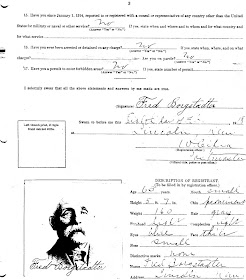.jpg)
Well they are actually my 2nd great grandparents. JOHN FRED BORGSTADTER came to the U.S. about 1871-1873 (depending on which census enumeration you read).
I found a Declaration of Intent sworn out by Fred Borgstadter to become a U.S. citizen filed in the Circuit Court of Cass County located in Virginia, Illinois. It is dated 12 February 1880 and he paid a fee of 50 cents to file it.
So I was surprised when I came across an index that listed Fred as having registered as an "Enemy Alien" in 1918 in Lincoln County, Kansas. He had filed his intent to become a citizen almost 40 years previously. Surely he completed the process?
Let's go back to 1880 - the year after Fred filed his intent, he married Elizabeth Hobrock in Beardstown, Cass County, Illinois on 24 March 1881. The first two of their four children are born here - Annie in 1882 and Henry in 1884. In the fall of 1886, the Borgstadters moved to Elkhorn Township, Lincoln County, Kansas. Here is where the last two children are born - Herman in 1891 and Clara in 1902.

After World War I started, non-naturalized "Enemy Aliens" were required to register with United States authorities as a national security measure. Kansas Enemy Aliens
Registrants include school children, divinity students, former United States soldiers and sailors, Roman Catholic nuns, the elderly and the infirm. Almost 6,000 affidavits were created by U.S. Marshals in Kansas .
Under the provisions of a Presidential Proclamation of April 6, 1917, non-naturalized female aliens were likewise registered as an additional national security measure that INCLUDED those women of American birth that were married to enemy aliens.
On 25 January 1918, all German aliens were given 5 days to register. Registration occurred at Police stations or in small towns at the Post Office. Filing first citizenship papers was not sufficient grounds for not registering.
When United States President Woodrow Wilson declared war, essentially two American battles broke out against Germany: one militarily in Europe and the other culturally in the United States. Twenty-six states passed laws against the use of German on the streets, via telephone, or in public meetings. Libraries eliminated German materials. Public schools removed all German language instruction from their curriculum. Segregated German-language church congregations merged with other, English-speaking congregations. German-language parochial schools either changed their curriculum or closed.
Buildings, towns, streets, foods—anything considered German was stripped of its ties to the fatherland and renamed to denounce Germany. Sauerkraut became Liberty Cabbage, and frankfurters were anglicized as hot dogs. Chicago’s Bismarck Hotel changed its name to the Hotel Randolph as a demonstration of patriotism.
I can't begin to imagine how my 2nd great grandmother must have felt when she was told that because her husband was not a naturalized citizen, they both were considered "Enemy Aliens." It was as if she were being arrested. They took her picture and her fingerprints. Registering meant filling out an eight page form, having to answer personal questions asked by a complete stranger. An intimidating stranger at that - A U.S. Marshall . During the years 1907-1922, a woman who married a foreigner lost her US Citizenship and took the nationality of her husband.
There is good news and bad news about these records. These files are full of vital genealogical information about the person. The bad news is that nearly all of them have been destroyed. Those remaining are all of the files from Kansas, those within the jurisdiction of the U.S. District Court for Phoenix, Arizona, Fort Wayne, Indiana and St. Paul, Minnesota. More good news: All of these are available online with at least the index.
World War One Alien Registration Records 1918
Arizona, U.S. District Court for the Phoenix Division of the District of Arizona
You can find an index of the names
hereFort Wayne, Allen County, Indiana
Database
hereSt. Paul, Minnesota
Index
hereKansas World War One Alien Registration
Indexes by the county
hereNARA has a searchable database of this set of records, but it is not indexed, and is difficult to search.
http://www.archives.gov/If all you find is the name indexed you can order the complete file here:
NARA's Central Plains Region (Kansas City) (NREKA)
2312 East Bannister Road
Kansas City, MO 64131-3011
PHONE: 816-926-6272
FAX: 816-926-6982
EMAIL: kansascity.archives@nara.gov






























.jpg)




